Speech The Economy in Late 2008: Conditions and Prospects

Malcolm Edey
Assistant Governor (Economic)
Australia & Japan Economic Outlook Conference 2008
Sydney –
Once again I'd like to thank AJEI and the Japanese Consulate-General for the invitation to speak here today.
I'll be basing my remarks on the RBA's latest quarterly economic statement, which was released last week. It's too early for there to have been any material change of view since then, and so I'd like to stress that I'm not in any way offering a different assessment to the one we gave then.
When I spoke at this event in March last year, the situation was very different from the one facing us today. Let me start by recapping some of the key features of the economic situation back then, as I summarised it at the time.
Global growth was above average, and was expected to remain so. Growth in the year just completed, 2006, was estimated to have been more than 5 per cent, making it the strongest year for the world economy in more than three decades. Forecasts by the IMF and other observers were that world growth would remain high in the two years ahead. That view turned out to be correct as far as 2007 was concerned although, as I'll come back to later, conditions have turned down sharply in the current year.
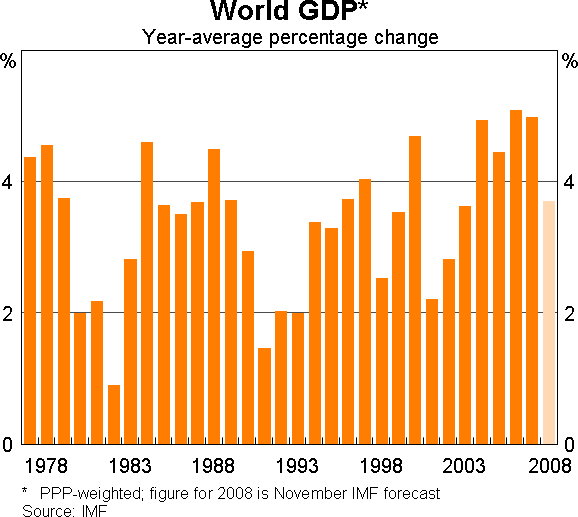
The main weak spot at that stage (in the first half of last year) was the downturn in the US housing sector, which was already well underway. But the US economy overall was still growing at a 3 per cent annual rate, and other parts of the world – notably Japan, the euro area, China, and the broader Asian region – were all picking up speed. I noted too that, in Japan, there were signs that the long period of balance sheet repair was showing some positive results. Bank lending was expanding again, and conditions in property markets were improving.
Another important feature of the economic situation at that time was the strength of global commodity prices. Measured in foreign currency terms, the index of Australia's commodity export prices was about 80 per cent higher than 2003 levels. Australia's terms of trade had risen by about 10 per cent per annum over the previous three years, and that was delivering a major boost to national income. This was partly a cyclical phenomenon, resulting from a period of above-average growth in world demand and output. But it was widely recognised that there was also a structural dimension to it, with Chinese and Indian industrialisation providing a major addition to world commodities demand. And at that stage, the big increases in coal and iron ore prices from the latest round of contract negotiations were still to come.
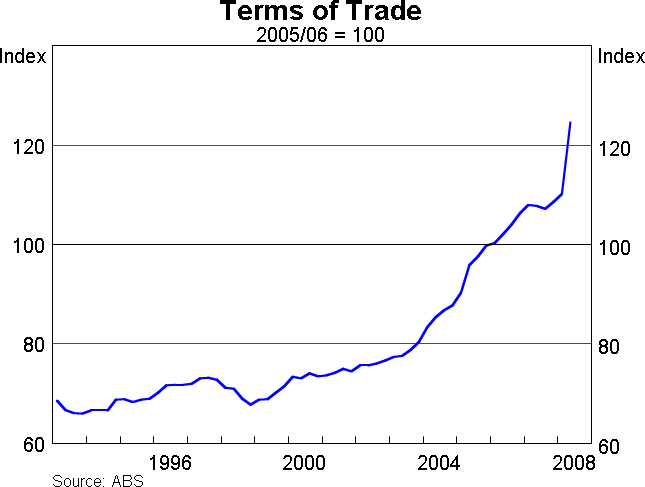
In short, the international situation at the time of last year's conference was one that was highly favourable to growth in incomes, spending and output in Australia. The sub-prime debt problem in the United States was just beginning to attract attention, but the wider ramifications from that were not yet apparent.
Against that background, growth of the Australian economy last year was strong. Unemployment fell to 30-year lows, and domestic demand over 2007 was growing at an annual rate of more than 5 per cent – which is well in excess of the growth of the economy's productive capacity. This was an environment where spare capacity was becoming very limited. One summary indicator that I commented on last year was the capacity utilisation series from the NAB business survey. By that stage, it had already reached its highest levels since the survey began, and it went on to rise further before it started to turn down during 2008.
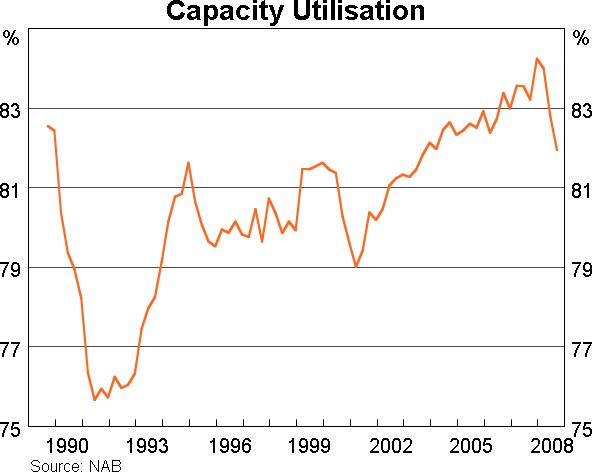
In this environment, it's not surprising that there was upward pressure on Australia's inflation rate. When I spoke last year, underlying inflation was running at an annual rate of 3 per cent. The latest quarterly figure at that point had softened a bit, but the annual rate was still higher than ideal, and the combination of strong demand and scarce productive capacity pointed to further inflation pressure in the period lying ahead.
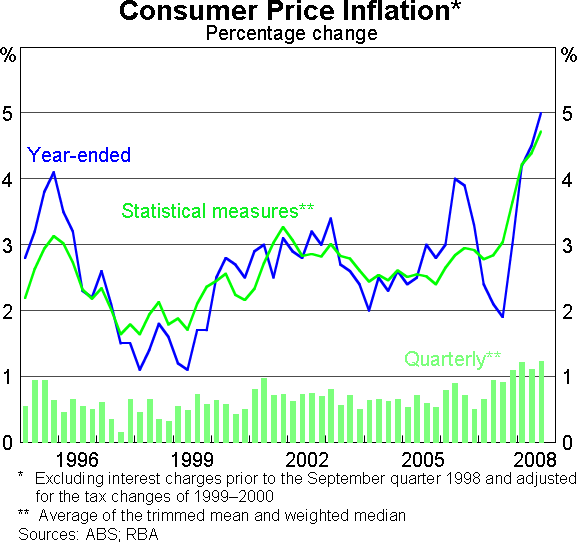
In the event, inflation in Australia did rise significantly further. On the latest figures, for the September quarter 2008, underlying inflation has now picked up to a rate of just over 4½ per cent, with the headline CPI at 5 per cent.
As in a lot of other countries, a significant part of the increase during this period was accounted for by food and energy prices. But it's worth making the point that the rise in inflation was quite broadly based. One way of illustrating that is to look at the proportion of items in the CPI rising at annual rates in excess of 2½ per cent. Given a roughly symmetric distribution of price movements, attainment of the inflation target requires that about half the items on average should be running above the target mid-point at any given time, and half below. But in the latest year, roughly three quarters of the items in the CPI, by weight, have been above that benchmark.
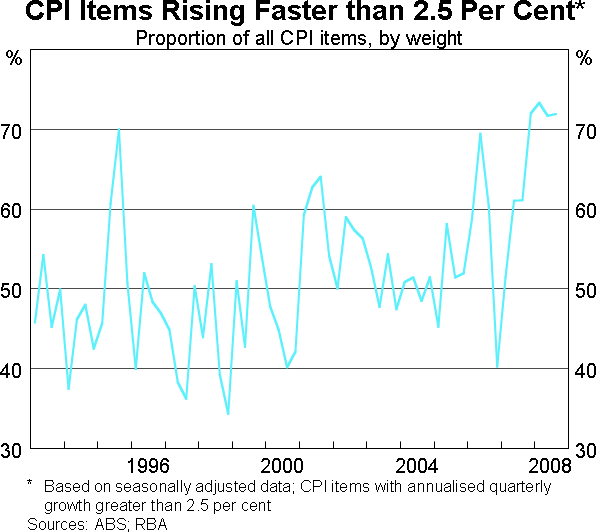
In fact, while global commodity prices have been an important contributing factor to inflation, the rise in Australia's inflation rate over the past two years was, to a significant extent, domestically driven. We can illustrate that by dividing the CPI into those components that have a significant international trade exposure and the remaining, predominantly non-traded items. Most of the rise in core inflation came from the non-tradables component, which picked up from around 3½ per cent to around 6 per cent over the last two years. In contrast, the tradables component, excluding volatile food and energy items, was relatively stable.
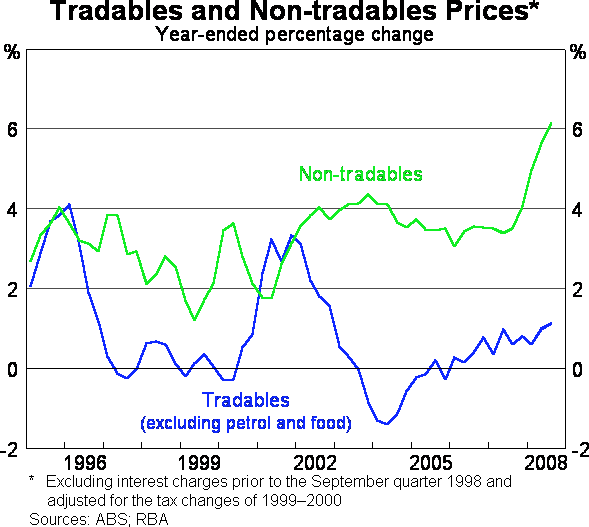
It's clear then that, coming into this year, the economic situation in Australia was one in which capacity utilisation was high, demand was growing strongly, and inflation was rising. It was against that background that the RBA was seeking to restrain demand, in order to exert downward pressure on inflation over time.
In turning now to discuss the current outlook, it's important to recognise that the extraordinary financial events of the past two months have had a major bearing on economic prospects, both internationally and in Australia. With that in mind, I want to focus the remainder of my remarks on two themes: namely, how conditions in Australia were developing in the period leading into those events, and how this new phase of financial turmoil might affect the global and Australian economies from here on.
The latest national accounts are somewhat outdated now, but they provide a useful summary of how things were evolving up to the middle of this year. They show that output growth slowed in the June quarter but was still running at an annual rate of 2.7 per cent. Domestic demand was growing at a higher-than-trend pace, but was also slowing. As a general observation, the accounts suggest that conditions up to around mid year at least were evolving more or less as expected, which is to say that growth was continuing but the required moderation in domestic demand was occurring.
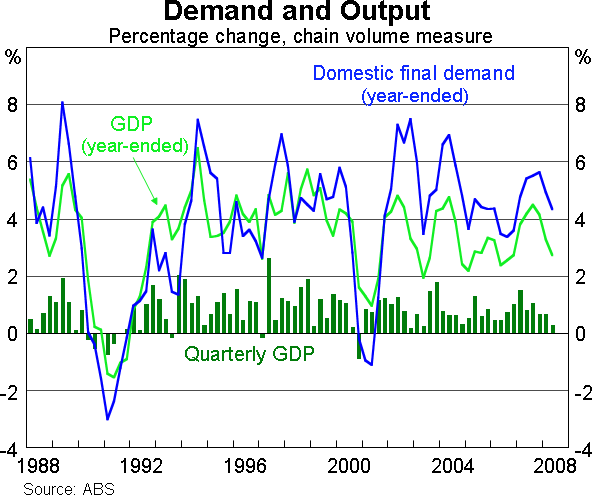
The slowing in demand to date has been driven largely by household spending. Consumption fell slightly in the June quarter, and the indications from retail sales data are that it stayed quite subdued in the September quarter. Households now seem to have entered a period of consolidation, in which their spending and indebtedness are growing more slowly than incomes. That adjustment, provided it remains orderly, should be helpful in laying the basis for sustainable growth in the longer term.
In contrast to the household sector, businesses were still increasing their spending quite strongly in the period up to mid year. A lot of that growth was mining-related, but even in the non-mining sector, business investment up till now has been running at above-average levels in relation to the size of the economy. Nonetheless, survey-based indicators of business activity confirm that conditions have softened, and a number of surveys are pointing to investment plans being scaled back in the period ahead. One of the factors contributing to that has been tighter financial conditions, with a number of businesses reporting greater difficulty in obtaining credit, particularly in the construction sector.
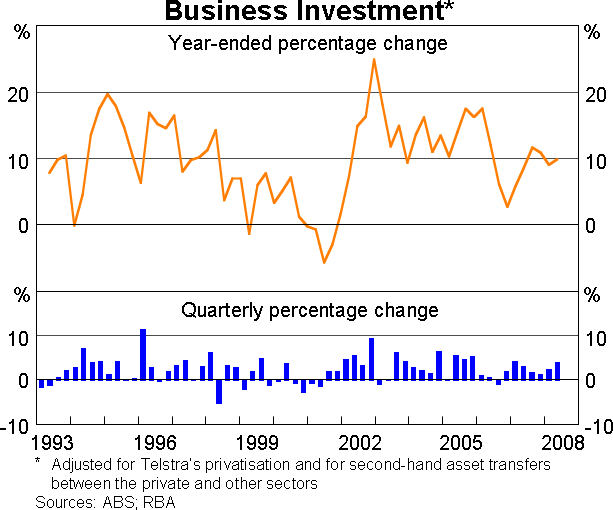
Labour market indicators also confirm that a significant moderation in the growth of economic activity has been occurring. Employment growth has eased back from a 3 per cent annual pace in the early part of this year to something closer to 1 per cent in the past few months. Unemployment is still close to its 30-year lows, but job vacancies have been declining, indicating some easing in the earlier scarcity of labour.
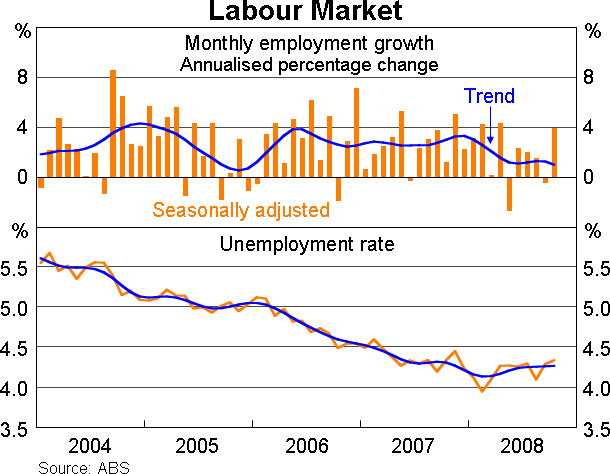
Taken together, then, we have a general picture based on recent data of sub-trend growth in the Australian economy. But the domestic indicators available to date still largely cover the period only up to the September quarter, and so they are of limited value in assessing the impact of the latest round of financial turmoil, which dates from mid September.
The trigger for this latest turmoil was the collapse of US investment bank Lehman Brothers, on 15 September, which itself followed the effective nationalisation of the US federal mortgage agencies during the previous week. These events were followed in quick succession by the nationalisation of the US insurer AIG, along with a string of other announcements of the failure or near-failure of various financial institutions in the United States and Europe.
All of this has been accompanied by some exceptional volatility in world financial markets. During September and October, US equity markets recorded some of their largest daily movements (in both directions) in history. In net terms, US equity prices have fallen by around 30 per cent since the Lehmans collapse. The Australian market is down by 25 per cent over the same period.
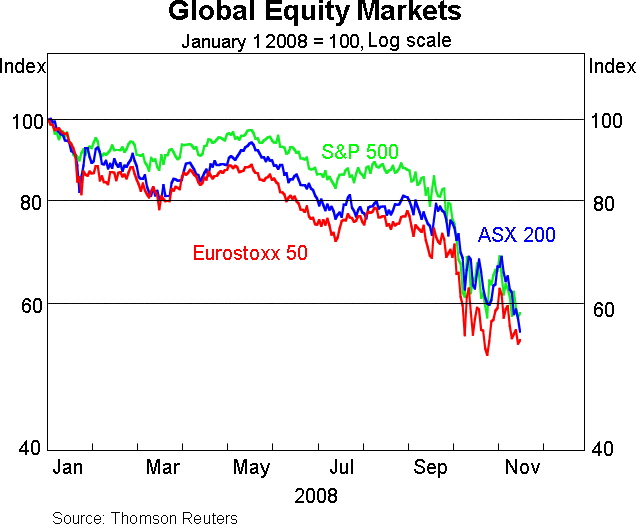
Policy-makers around the world have responded to these developments in a number of ways. Central banks have been adding liquidity to their financial systems, and they have been cutting official interest rates. Some governments, including Australia, have announced substantial fiscal stimulus packages. And governments around the world have taken direct measures to strengthen their financial systems, including capital injections, enhanced protection for retail deposits, and the offer of guarantees to various types of wholesale lending. These steps should help to stabilise conditions over time, but sentiment is still fragile.
In addition to the volatility in financial markets, commodity prices have fallen sharply during this period. Some of that was already happening, but the renewed episode of financial turmoil has accentuated the trend. Oil prices are now trading below US$60 a barrel, having peaked in July at close to US$146. Base metals prices have fallen by around 35 per cent since early September. And spot prices for steaming coal and iron ore are now trading below current contracts, having been at premiums of 40 per cent or more around mid year. These are big movements, although it has to be acknowledged that the prices of some key resource commodities are still high in absolute terms.
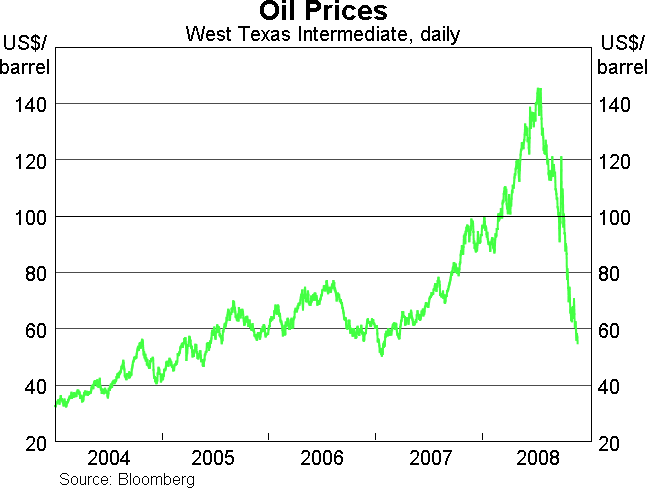
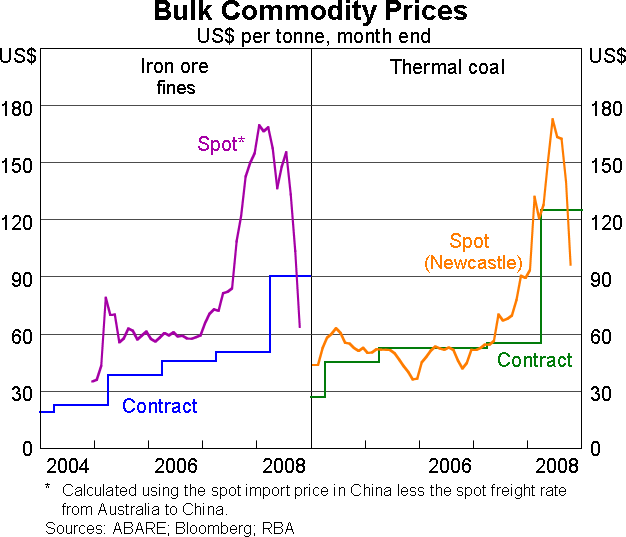
Obviously these market developments present significant uncertainties for the world economy as a whole. Conditions in some of the major economies were already softening when the latest turmoil broke out, and these recent events have prompted sharp downward revisions to official forecasts in the last few months. As recently as August, IMF forecasts were for world growth in 2009 to be nearly 3¾ per cent, or close to its long-term average. In response to the recent financial turmoil and other new information, that forecast was revised to 3 per cent in October, and again to 2.2 per cent by early November. This figure incorporates a fall in GDP in the G7 economies, and sharply reduced growth in the developing world. On the positive side, lower prices of oil and other commodities should assist consumers around the world, and will also help to reduce global inflation.
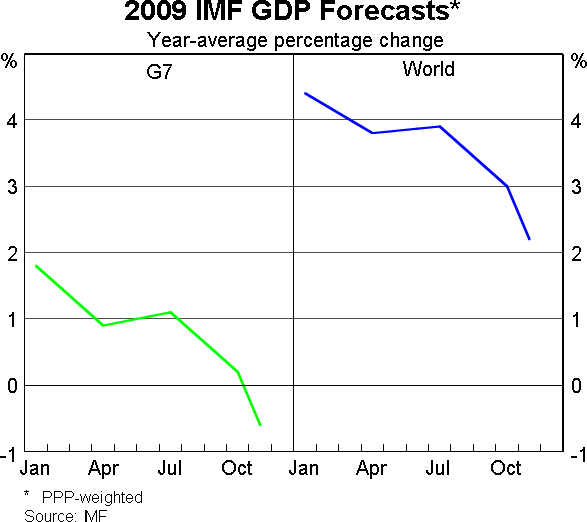
In assessing the impact of all this on the Australian economy, it is important to take into account some significant factors working in the other direction. The official cash rate has been reduced by a total of 200 basis points since September. The fiscal package announced by the Government in October will provide a near-term stimulus of a bit under 1 per cent of GDP. An additional factor is the depreciation of the Australian dollar exchange rate, which in trade-weighted terms is down by about 25 per cent over the past three months. All of these factors will help to cushion the effects of the much more difficult global environment in which we now find ourselves.
Even so, the forecasts that we released last week envisage a significant further slowing in the Australian economy from the pace recorded at mid year. Growth of non-farm GDP is now expected to reach a trough of 1 per cent in year-ended terms by the middle of next year, and to remain below trend for some time beyond that.[1] Inflation is likely to fall. But it has to be emphasised that any forecasts in this environment are subject to a great deal of uncertainty, not least because the situation in world financial markets is still changing rapidly.
| June 2008 | June 2009 | June 2010 | June 2011 | |
|---|---|---|---|---|
| GDP | 2.7 | 1½ | 2 | 3 |
| Non-farm GDP | 2.5 | 1 | 2 | 3 |
| CPI | 4.5 | 3 | 3¼ | 2½ |
| Underlying inflation | 4.4 | 4 | 3¼ | 2½ |
|
(a) Actual data to June 2008. Underlying inflation refers to the average
of trimmed mean and weighted median inflation. For the forecast period,
technical assumptions include A$ at US$0.70, TWI at 57, cash rate at 5.25
per cent, and WTI crude oil price at US$70 per barrel and Tapis crude oil
price at US$72 per barrel.
Sources: ABS; RBA |
||||
Endnote
In year-average terms, the RBA forecasts imply GDP growth of 1.6 per cent in 2008/09 and 1.8 per cent in 2009/10. These forecasts are slightly lower than those in the recent Mid-Year Economic and Fiscal Outlook (MYEFO), but the two are not strictly comparable as the RBA forecasts assume a constant cash rate, whereas those in MYEFO are based on a market path for the cash rate. [1]